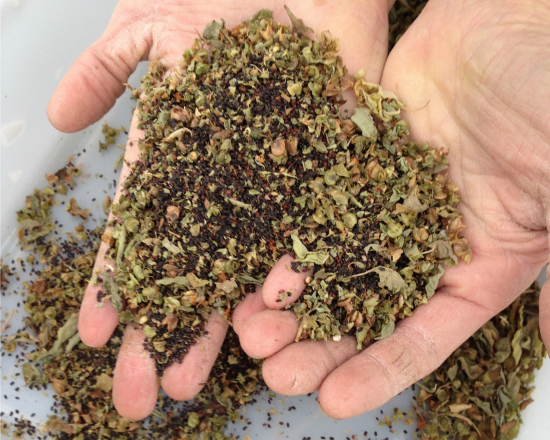
Many farmers take a break while the fields are frozen. Not Zach Pickens. “This is definitely my busy season,” Pickens told me one frigid afternoon last week.
Spring through fall, Pickens is out in the sunshine tending the urban farm at Riverpark restaurant, but he also runs his own business, saving and selling “Rooftop Ready” seeds regionally adapted for New York City gardens. That means flowers, herbs and vegetables he’s specifically selected for urban container gardens perched on windowsills, stoops and fire escapes. He grows all of his own seeds right here in the city, letting the plants go completely to seed, drying them for several months and, come winter, threshing, winnowing and packing them for the New Yorkers who start planning their plantings as spring draws nigh.
Zach’s annual process starts the spring before, when he plants heirloom seeds that he predicts will perform well in the urban jungle. Then he watches each breed carefully, sees what varieties flourish, and of those, saves the seed from the best specimens to sell the following year as Rooftop Ready.
Last year he grew in three locations: his own Bushwick rooftop — complete with a 200-square-foot greenhouse and a 600-square-foot garden up there — as well as growing some plants for seed at Riverpark and some at Brooklyn Grange at the Navy Yard farm. This year the busy urban farmer will add one more garden — at Weeksville Heritage Center in Brownsville.
His top criteria is plants that grow well in the botanical answer to the New York studio apartment: containers. That means no corn or winter squash, which just need too much space for urban environs. Sure, some urban gardeners manage with these, but Zach says it’s hard to keep them well hydrated in pots, and stressed plants don’t thrive.
Instead his lineup includes lots of pot-friendly plants, all marketed as regionally adapted. Everything from greens to beans, herbs and amaranth. His other criteria is, as he puts it “what I like!” That’s why ground cherries and shishito peppers make his short-list.

This year, his 17 new varieties bring him up to a total of 40. One 2014 addition is an heirloom bean called Cherokee Trail of Tears. Like something from a fairty tale, the tall, trellising beanstalk grows straight up, yielding a heavy crop of long green snap bean with blush red tones. But while Zach has high standards for plant performance, he’s also partial to this bean’s politics: “I got it from a seed swap when Occupy Wall Street did a march against Monsanto in the Fall of 2011,” he recalls happily. “I brought seeds to swap, took a few, grew this one out. This is the first year I’m selling it. I like the spirit of that — an open-pollinated plant from an anti-Monsanto march!”
But before he can sell it, he’s got lots to do.
“Seed companies are busiest this time of year,” he says. “This is definitely the ramp up for the growing season.”
He allowed each crop to mature and fully go to seed by last fall, when he harvested whole plants and left them to dry completely. Now it’s time to thresh them (“basically smashing open the husks and freeing the seeds”) and then put them through a series of screenings or winnowings to literally separate the wheat from the chaff.
Lastly, he has his envelopes screen-printed and properly packs each seed so it’s ready to go when gardeners send in their orders on his website, or at the three shops that carry Rooftop Ready seeds.
A few gardeners from Chicago and even Virginia have become customers, but at least 90 percent of Rooftop Ready seeds are right here in the city. Last year he sold a thousand packs — a number he expects to double this year. But, in the lingo of a farmer who grows in pots, he says that for a seed company, two thousand packs is just small potatoes.



